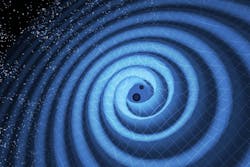On the heels of its inaugural detection of gravitational waves, LIGO scientists have directly detected gravitational waves again; this time, the team has determined that the incredibly faint ripple that eventually reached Earth was produced by two black holes colliding at half the speed of light, 1.4 billion light years away. These gravitational waves--ripples through the fabric of space-time, created by extreme, cataclysmic events in the distant universe--were detected using the twin Laser Interferometer Gravitational-wave Observatory (LIGO) interferometers, located in Livingston, LA and Hanford, WA. On December 26, 2015, at 3:38 UTC, both detectors, situated more than 3000 kilometers apart, picked up a very faint signal amid the surrounding noise.
RELATED ARTICLE: Gravitational wave discovery supports cosmic expansion from the Big Bang
While LIGO's first detection produced a clear peak, or "chirp," in the data, this second signal was far subtler, generating a shallower waveform--essentially a faint squeak--that was almost buried in the data. Using advanced data analysis techniques, the team determined that indeed, the waveform signaled a gravitational wave.
The researchers calculated that the gravitational wave arose from the collision of two black holes, 14.2 and 7.5 times the mass of the sun. The signal picked up by LIGO’s detectors encompasses the final moments before the black holes merged: For roughly the final second, while the signal was detectable, the black holes spun around each other 55 times, approaching half the speed of light, before merging in a collision that released a huge amount of energy in the form of gravitational waves, equivalent to the mass of the sun. This cataclysm, occurring 1.4 billion years ago, produced a more massive spinning black hole that is 20.8 times the mass of the sun.
This second detection of gravitational waves, which once again confirms Einstein's theory of general relativity, successfully tested LIGO's ability to detect incredibly subtle gravitational signals.
"We did it again," says Salvatore Vitale, a research scientist in MIT's Kavli Institute for Astrophysics and Space Research and a LIGO team member. "The first event was so beautiful that we almost couldn’t believe it. Now, the fact of having seen another gravitational wave proves that indeed we are observing a population of binary black holes in the universe. We know we'll see many of these frequently enough to make interesting science out of them."
The scientists, as part of the LIGO Scientific Collaboration and the Virgo Collaboration, have published their results in Physical Review Letters.
LIGO's two interferometers, each 4 km long, are designed in such a way that each detector should stretch by an infinitesimal amount if a gravitational wave were to pass through. On September 14, 2015, the detectors picked up the very first signal of a gravitational wave, which stretched each detector by as little as a fraction of a proton's diameter. Just four months later, on December 26, LIGO recorded a second signal, which stretched the detectors by an even smaller amount.
Continue reading the news per the SOURCE information below for more details …
This research was funded by the National Science Foundation. LIGO was designed, built, and is operated by Caltech and MIT.
SOURCE: MIT News; http://news.mit.edu/2016/second-time-ligo-detects-gravitational-waves-0615

Gail Overton | Senior Editor (2004-2020)
Gail has more than 30 years of engineering, marketing, product management, and editorial experience in the photonics and optical communications industry. Before joining the staff at Laser Focus World in 2004, she held many product management and product marketing roles in the fiber-optics industry, most notably at Hughes (El Segundo, CA), GTE Labs (Waltham, MA), Corning (Corning, NY), Photon Kinetics (Beaverton, OR), and Newport Corporation (Irvine, CA). During her marketing career, Gail published articles in WDM Solutions and Sensors magazine and traveled internationally to conduct product and sales training. Gail received her BS degree in physics, with an emphasis in optics, from San Diego State University in San Diego, CA in May 1986.
